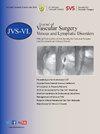基于方案的静脉曲张自发性出血治疗可预防出血复发。
IF 2.8
2区 医学
Q2 PERIPHERAL VASCULAR DISEASE
Journal of vascular surgery. Venous and lymphatic disorders
Pub Date : 2025-01-01
DOI:10.1016/j.jvsv.2024.101988
引用次数: 0
摘要
背景:静脉曲张侵蚀皮肤引起的自发性出血是静脉曲张疾病的一种严重并发症,有时甚至是致命的并发症。目前已提出了各种急性和延迟治疗方法。我们的两步临床方案旨在毫不拖延地防止进一步出血,并持久避免再次出血:方法:所有因静脉曲张出血而转诊到我们静脉外科诊所的患者都被纳入前瞻性登记册。所有患者在就诊时都接受了静脉回流的双工超声诊断。即时治疗包括在超声引导下对出血的曲张静脉和邻近静脉进行聚多卡诺醇/二氧化碳泡沫硬化剂治疗。随后在八周内安排并实施了静脉内消融术,以治疗下腔无力的中轴静脉,并在必要时同时进行微静脉切除术:49名患者是在四年内因静脉曲张大出血而转诊的。56人(95%)的出血点下有超声波确定的支静脉曲张,3人只有皮肤表面糜烂,没有超声波确定的支静脉曲张。在 59 位接受研究的患者中,有 52 位接受了及时的聚多卡诺/二氧化碳泡沫硬化剂治疗,治疗的目标既包括潜在的支流(如果存在),也包括皮肤出血曲张。其余 7 人要么拒绝接受硬化剂治疗,要么不符合条件。54例(92%)患者被发现患有轴向(大隐静脉、小隐静脉或前隐静脉)静脉功能不全。在这些躯干静脉功能不全的患者中,有 48 人接受了消融治疗,其中 5 人拒绝接受,1 人因身体虚弱无法接受进一步干预。从立即进行硬化疗法到计划进行消融术的间隔期间,没有再发生出血。在平均 2.2 年的随访期间,有 4 名患者(7%)出现了晚期复发性出血:其中一名患者未能按时接受消融术,两名患者正在接受长期抗凝治疗,一名患者患有严重的右心衰竭。所有四名患者都接受了再治疗,没有再复发:超声引导下立即进行泡沫硬化剂治疗,然后在八周内对闭锁的轴静脉进行静脉腔内消融术,并同时进行微静脉切除术,这种两步疗法既快速又有效,而且能持久避免再次出血。本文章由计算机程序翻译,如有差异,请以英文原文为准。
Protocol-based treatment of spontaneous hemorrhage from varicose veins prevents recurrence of bleeding
Background
Spontaneous hemorrhage from erosion of varicose veins through the skin is a serious and occasionally fatal complication of varicose vein disease. Various treatments, both acute and delayed, have been advocated. Our two-step clinical protocol was designed to prevent further hemorrhage without delay and to provide durable freedom from recurrent bleeding.
Methods
All patients referred to our surgical vein practice with hemorrhage from varicose veins were entered into a prospective registry. On presentation, all patients underwent diagnostic duplex ultrasound for venous reflux. Immediate treatment consisted of ultrasound-guided polidocanol/CO2 foam sclerotherapy of the bleeding varicosity and adjacent veins. Subsequent endovenous ablation of underlying incompetent axial veins, with concurrent microphlebectomy when indicated, was scheduled and performed within 8 weeks.
Results
Fifty-nine patients were referred with recent hemorrhage from varicose veins over a period of 4 years. Fifty-six (95%) had an ultrasound-identified tributary varicosity underlying the point of bleeding, and three had a skin-surface erosion only and no ultrasound-identified underlying tributary. Of the 59 study patients, 52 underwent prompt polidocanol/CO2 foam sclerotherapy, targeted to both the underlying tributary (when present) as well as the cutaneous bleeding varicosity. The remaining seven either declined sclerotherapy or were ineligible. Underlying incompetence of axial (great, small, or anterior saphenous) veins was found in 54 patients (92%). Of these patients with truncal vein incompetence, 48 underwent ablation—5 declined and 1 was too frail for any further intervention. There were no recurrent bleeds in the interval between immediate sclerotherapy and scheduled ablation. During a mean follow-up of 2.2 years, 55 of the 59 patients (93%) had no recurrence of bleeding. Four patients (7%) had late, recurrent hemorrhage: one had failed to return for their scheduled ablation, two were on chronic anticoagulation, and one had severe right heart failure. All four were retreated without further recurrence.
Conclusions
A two-step protocol of immediate ultrasound-guided foam sclerotherapy, followed within 8 weeks by endovenous ablation of incompetent axial veins and concurrent microphlebectomy, provided rapid and efficient treatment with durable freedom from subsequent hemorrhage.
求助全文
通过发布文献求助,成功后即可免费获取论文全文。
去求助
来源期刊

Journal of vascular surgery. Venous and lymphatic disorders
SURGERYPERIPHERAL VASCULAR DISEASE&n-PERIPHERAL VASCULAR DISEASE
CiteScore
6.30
自引率
18.80%
发文量
328
审稿时长
71 days
期刊介绍:
Journal of Vascular Surgery: Venous and Lymphatic Disorders is one of a series of specialist journals launched by the Journal of Vascular Surgery. It aims to be the premier international Journal of medical, endovascular and surgical management of venous and lymphatic disorders. It publishes high quality clinical, research, case reports, techniques, and practice manuscripts related to all aspects of venous and lymphatic disorders, including malformations and wound care, with an emphasis on the practicing clinician. The journal seeks to provide novel and timely information to vascular surgeons, interventionalists, phlebologists, wound care specialists, and allied health professionals who treat patients presenting with vascular and lymphatic disorders. As the official publication of The Society for Vascular Surgery and the American Venous Forum, the Journal will publish, after peer review, selected papers presented at the annual meeting of these organizations and affiliated vascular societies, as well as original articles from members and non-members.
 求助内容:
求助内容: 应助结果提醒方式:
应助结果提醒方式:


